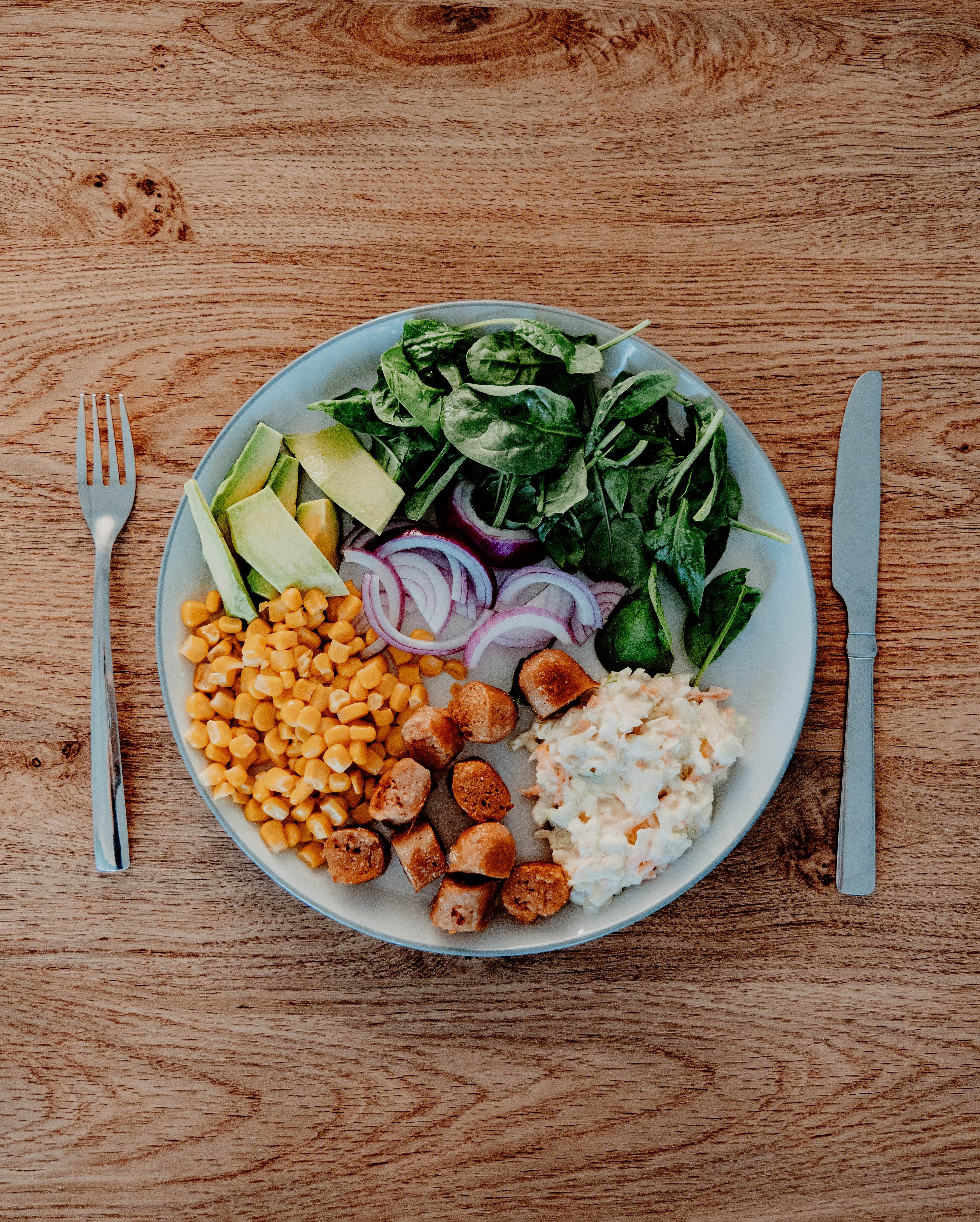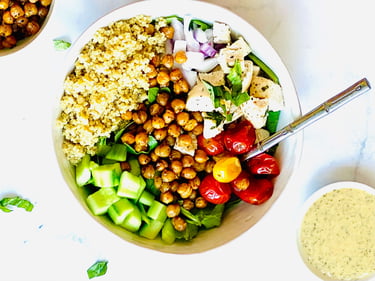Top 8 Myths about eating right— and how to make simple healthy choices
February 21st, 2024 | 7 min. read
By Jen Azevedo

Most people spend the majority of their waking hours working hard, juggling work, kids, and chores — while trying to make healthy lifestyle choices. We all know it is important to be active and “eat right.” But what does eating right actually look like?
There are dozens of articles published each week with “new” or “cutting-edge” theories about nutrition. Some of these reports are comprised of old recycled information, and some are new fad ideas that play on humans' desire to stay on trend.
The Paseo Club is a social club in the Santa Clarita Valley that offers fitness, court, and swimming facilities to the community of members. We have certified instructors and nutritionists on staff to help advise and support people in their fitness goals.
In this article, we will address why eating well is essential, some common myths about eating right, and tips to get on the right track.
 Why is what we eat important?
Why is what we eat important?
Although our bodies are technically not engines, they function similarly. The quality of the fuel affects the functioning of the system. Eating well enhances both mental and physical health. Consuming the proper nutrients…
- Promotes longevity and overall well-being
- Improves organ, bone, skin, muscle, and heart health
- Lowers the chance of depression and other mental health disorders
- Lowers the risk of heart disease, type 2 diabetes, chronic disease, and some cancers
What are the top 8 myths about eating right?
Knowing what to eat can be confusing. There are a lot of theories about nutrition. Below are the most common myths about eating right and what you can do to eat healthily.
1. Listen to anecdotal stories and follow fad diets
Do you have a friend who is a health enthusiast and tries out all the latest diet fads? Have you seen the food hype on your Instagram feed? Dozens of different diet theories make it in the headlines, exciting us to try their quick-fix program.
Many people learn about proper nutrition from their friends or social media. Undoubtedly, your friends (and maybe your influencers) have your best interests at heart, but a lot of nutrition information is word-of-mouth and not grounded in science.
Whether it is the carnivore diet, eating anything you want as long as it is between noon and 6 pm, or the broccoli and chicken breast plan — there are dozens of theories about how to eat right.
Unfortunately, what all these fad diets have in common is restriction. It is not difficult to follow a strict diet and get results. But what is difficult is to commit to such a diet for any length of time.
Health Tip: Diets fail. All diets fail. Nobody can measure, count, and restrict indefinitely. It is not a sustainable practice, so instead of focusing on diets or passing theories about nutrition, create a healthy lifestyle grounded in science that can last you forever.
 2. One diet fits all
2. One diet fits all
When people study nutrition, they are looking for the right approach. They cross-compare different theories and choose a concept that they think is best.
But many people do not know that there is no one-size-fits-all approach to eating. What works for one person will be different for another.
Health Tip: Age, gender, size, activity level, and overall health are factors that need to be considered in order to develop the best methods for eating right for you.
3. Ignore nutrient timing
Nutrient timing is a method of choosing when you will have your largest meals and at what time. It takes into account your body’s natural rhythms and metabolism.
People often think that eating right is based exclusively on what food they select. But when you eat heavily influences whether you experience weight loss, stabilization, or gain.
Nutrient timing encourages people to eat a larger, more protein-rich meal at breakfast, a moderate-sized lunch, and a small evening meal. When you go to bed, your body goes into fat-burning mode as it fasts.
Health Tip: In the morning, you break your fast with a large, nourishing meal, thus starting the cycle again.
4. When you are tired, drink more coffee
The mid-afternoon energy slump is something most of us experience daily. Around 2 pm, productivity at work dips, and we feel fatigued and more apt to stare out the window than problem-solve a project.
Most adults combat this challenge by pouring themselves (another) cup of coffee (or grabbing a quad shot latte). But that fatigue you feel in the afternoon is not your body crying for caffeine.
Your blood sugar has dropped, and your body is hungry. More coffee (especially with added sweetener or accompanied by a pastry) will only give you higher highs and lower lows.
Health Tip: Use this time for a healthy, small high-protein snack such as nuts and an apple, some turkey jerky and cheese, hummus and veggie sticks, or yogurt with berries.
 5. Carbs are the enemy (and its evil cousin, fat)
5. Carbs are the enemy (and its evil cousin, fat)
Many believe that if they just avoid certain foods, they will be healthy and at their target weight. The low-fat craze of the 80s and the Atkins fandom of the 90s gave many of us a skewed perspective about eating right.
According to PubMed, carbs function as an “energy source, help control blood glucose and insulin metabolism, and participate in cholesterol and triglyceride metabolism.”
Fat gives us satiety. It also helps give energy, protects your organs, supports cell growth, regulates cholesterol and blood pressure, and helps your body absorb vital nutrients.
This research, and others like it, means that carbs and fat are not only essential to eating right, they are crucial for the functioning of our bodies.
Health Tip: Choose healthy carbs such as sweet potatoes, winter squash, brown rice, and lentils. Healthy fats include olive and coconut oils, nuts, and avocados.
6. Are you calculating your protein intake correctly?
Many of us have heard that we need to optimize our protein intake — especially for maintaining a healthy amount of lean muscle. This is true, but many people eat way more protein than they need to. The culprit is the grams of protein-to-bodyweight ratio that has gotten so much press.
But what was that ratio of protein intake? Do you eat a gram of protein for every pound of body weight? Maybe it was half a gram… hard to remember. Right?
Well, the fact is that the concept of using the grams of protein to bodyweight ratio came from a metric-using country where it was not grams to pounds — it was grams to kilograms — a vastly different measurement.
The recommended protein intake is based on 1 gram of protein for 1 kilogram of body weight. One kilogram is equivalent to 2.2 pounds. A 150-pound person weighs about 68 kilos. That person would need approximately 68 grams of protein. But, as noted above, not all bodies are the same, and these are guidelines.
Health Tip: Healthy proteins include chicken, legumes, salmon, some lean red meats, nuts, and full-fat dairy.
 7. White sugar is ok to eat as long as you don’t eat too much
7. White sugar is ok to eat as long as you don’t eat too much
If you have ever spent time reading labels at the grocery store, you know that added sugar is in almost every packaged food — and not just the obvious ones like cookies and candy bars.
You can find white sugar in pasta sauce, yogurts, salad dressing, marinades, and in almost all prepared drinks such as soda, tea, and juices. (This begs the question, where is there no sugar?)
The number of people with diabetes, high blood pressure, and heart problems — not to mention dental caries — continues to grow, and there is research linking those illnesses with sugar. According to Dr. Hu of Harvard, “the higher the intake of added sugar, the higher the risk for heart disease."
Eating sugar in moderation is harder than most of us would like to admit. But do not feel bad about it — sugar is addictive. The British Journal of Sports Medicine reports that the consumption of sugar has drug-like effects, including binging, craving, tolerance, withdrawal, cross-sensitization, cross-tolerance, cross-dependence, reward, and opioid effects.
Health Tip: Avoiding added sugars is the best approach to healthy eating. Try to lean on fresh and dried fruits for when you want something sweet, and read your labels to find sugar-free alternatives to your favorite prepared sauces, soups, and beverages.
 8. Ridding your cupboard of additives isn’t that important
8. Ridding your cupboard of additives isn’t that important
When you shop for groceries, you try to make healthy choices — more veggies, fresh fruits, lean meats, and good fats. But as soon as you step away from buying raw ingredients and want to grab a prepared item, the challenge begins.
There are more than 10,000 U.S. Food and Drug Administration (FDA) approved additives to preserve, package, or modify the taste, look, texture, or nutrients of foods. However, increasing evidence suggests food additives should be avoided.
According to the Journal of the Academy of Nutrition and Dietetics, over 60% of food has chemical additives. Some of these high-risk additives are:
- Red #3 dye causes thyroid tumors in rats and was banned in Europe in 1994.
- Propylparaben is a preservative found in many packaged snacks and baked goods. It is associated with impacting the endocrine (hormone) system and lowered fertility rates.
- Titanium dioxide is a color additive recently banned in Europe. According to the Center for Science in the Public, nanoparticles of titanium can accumulate in the body and cause DNA damage. CSPI rates this ingredient as a product to avoid.
- Brominated vegetable oil (BVO) is an emulsifier found in dozens of beverages. Animal studies indicate that BVO is transferred to nursing infants and can cause heart lesions, fatty changes in the liver, and impaired growth and behavioral development, making this ingredient — especially concerning for babies and children.
Health Tip: Go to the grocery store when you have time to read the labels of some of your favorite prepared foods. If you see anything in the ingredients you cannot pronounce, that is often a sign that it is an additive, and it is best to avoid it.
 How to make simple healthy choices
How to make simple healthy choices
Fitness instructor Andrew Basile of the Paseo Club often says to his clients, “Eating right is simple — but not easy.”
Eating right is simple because all we need to do is conduct most of our shopping around the perimeter of the supermarket. This is where the produce, eggs, dairy, poultry, fish, and lean meats are stored. Dip into the center of the stores for some grains and legumes and a few healthy, low-sugar prepared items.
But Coach Andrew is correct that these changes are not easy to make. Sugar is addictive, additives are in most processed foods, and healthy eating takes more time — something everyone is struggling with.
Here are some tips to make eating right easier.
- Cook in bulk. Leftovers are a saving grace for a busy family.
- Cook simply. You do not need to be a Michelin-starred chef. If you like making more elaborate meals, save it for the weekend when you have more time.
- Get the kids involved. Younger ones can help stir pots or chop veggies. Teens can make simple meals for the entire family.
- Make one meal for everyone. Many parents get stuck making multiple options to meet the needs of every member of the family. Most children will eat healthily when they are given regular exposure to different types of food. Just keep trying.
- Use modern tools such as Instant Pots and air fryers. They save you tons of time, and with the Instant Pot you can turn it on anytime, and it'll keep food warm until you are ready to eat.
- Prepare a few raw ingredients to make different meals. Cook a whole chicken for stir-fries, chicken salad, and soup.
The Paseo Club is your home away from home for health and fitness. We offer over 60 fitness classes each week, plus tennis, pickleball, and swim programs for members of all ages and abilities.
Enjoy a meal at the cafe, a massage at the onsite spa, or visit with other members at one of our many social or charitable events. Kids Club cares for children from 3 months through 12 years.
If you are interested in attending a community-focused private club, the Paseo Club may be a great fit for you. Schedule a tour of the club and meet members, instructors, and staff.
Jen Azevedo is a tennis professional, pickleball professional, personal trainer, group exercise instructor, and the general manager of the Paseo Club. She loves the community at the Paseo Club and that it is also a safe and fun place for her daughter. Jen’s favorite activities are joining her tribe for trail races or her partners for tennis matches. Occasionally Jen slows down to relax with a book — she reads over 100 a year!

